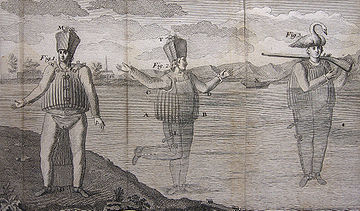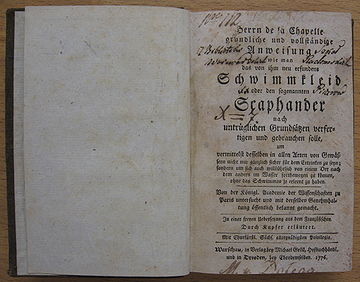Jean-Baptiste de La Chapelle
Jean-Baptiste de La Chapelle (* around 1710; † probably 1792 in Paris ) was a French mathematician , inventor and one of the main contributors to the Encyclopédie for the subject area of mathematics .
life and work
The exact dates of life of Jean-Baptiste de La Chapelle are unknown. When the first volume of the Encyclopédie appeared in 1751 , he was in his thirties or forties and living in Paris . Until at least 1734 he had earned his living as a math teacher. He had emerged as a translator of medical works and had published several works on elementary mathematics . In 1747 he was accepted into the London Royal Society and from 1751 he was active as a royal censor.
He came to work on the Encyclopédie through his acquaintance with d'Alembert , who valued La Chapelle as the author of the works Institutions de géométrie and Traité Des Sections Coniques and who recruited him for the subjects of arithmetic and geometry . In total, La Chapelle contributed more than 270 articles to the Encyclopédie and was represented as a contributor in all volumes except for the twelfth volume (his articles are marked with the abbreviation "E"). According to Luneau de Boisjermain (1732–1801), Denis Diderot is said to have commented on La Chapelle's work that he did his job “a little nimble” and that his mathematical articles were inferior to those of d'Alembert.
In 1763, La Chapelle published an educational pamphlet entitled L'Art de communiquer ses idées (Eng. "On the Art of Communicating Your Thoughts") in which he made suggestions on topics such as language, history, mathematics and Religion should be taught.

La Chapelle became better known in 1765 for his experiments with a life jacket made of cork, which he claimed to have invented. In front of a large audience he jumped into the Seine and ate, drank, sniffed, fired a pistol and wrote while floating on the surface. When he saw this demonstration three years later in the presence of Louis XV. wanted to repeat near the royal hunting lodge in the forest of Sénart, the attempt failed. La Chapelle was being swept away by the current so quickly that Ludwig could not see what was going on. In 1775, La Chapelle finally published a book about his findings under the title Traité de la Construction théorique et pratique du Scaphandre ou du Bateau de l'Homme , which was translated into German in 1776 and into Dutch in 1777.
Held a particular fascination also ventriloquism on him. On the basis of studies that La Chapelle carried out on a shopkeeper from Saint-Germain-en-Laye who was particularly talented in this art , he wrote a work on ventriloquism in 1772 under the title Le Ventriloque, Ou L'Engastrimythe , which was still in the 19th century Century was considered the standard work on the subject.
For the years after 1775 there is hardly any evidence of La Chapelle's life and work. In 1783 he led a lawsuit against one of the sons of his former publisher Jean Debure for a lifelong pension of 400 livres . After that his track is lost.
Works (selection)
- Discours sur l'Étude des Mathématiques. Paris 1743
- Institutions de Géométrie, enrichies de notes critiques et philosophiques sur la nature et des développements de l'esprit humain; précédées d'un Discours sur l'Étude des Mathématiques. (2 volumes), Paris 1746, 1757
- Traité des sections coniques et autres courbes anciennes, appliquées et appliquables à la pratique des differents arts. 1750
- L'Art de communiquer ses idées, enrichi de notes historiques et philosophiques. London 1763
- Le Ventriloque, ou l'Engastrimythe. London and Paris 1772
- Traité de la Construction théorique et pratique du Scaphandre ou du du bateau de l'homme, approuvé par l'Académie des Sciences. Paris 1774; New edition under the title Traité de la construction théorique et pratique du scaphandre ou bateau de l'homme… par M. de La Chapelle. Nouvelle édition… Précédé du Projet de formation d'une légion nautique ou d'éclaireurs des côtes, destinée à opérer tels débarquemens qu'on avisera sans le secours de vaisseaux… par… La Reynie… [Jean-Baptiste-Marie-Louis de La Reynie de La Bruyère] Paris to XIII [1805]
literature
- La Chapelle, abbé Jean Baptiste de , in: Frank Arthur Kafker, The encyclopedists as individuals: a biographical dictionary of the authors of the Encyclopédie, Oxford 1988, ISBN 0-7294-0368-8 , pp. 181-184.
Web links
Individual evidence
- ↑ Kafker, The encyclopedists as individuals, p. 181 gives birth and death dates as unknown. The dates mentioned here are based on the entry “La Chapelle (N…, abbé de)”, in: JCF Hoefer, Nouvelle biographie générale , Paris 1852.
- ↑ Frank A. Kafker: Notices sur les auteurs of dix-sept volumes de "discours" de l'Encyclopédie. Recherches sur Diderot et sur l'Encyclopédie Année 1989 Volume 7 Numéro 7 p. 145
- ↑ In his Discours préliminaire for the first volume of the Encyclopédie , d'Alembert writes: “L ' Arithmétique & la Géométrie élémentaire ont été revûes par M. l'Abbé de la Chapelle, Censeur royal & membre de la Société royale de Londres. Ses Institutions de géométrie , & son Traité des Sections coniques , ont justifié par leur succès l'approbation que l'Académie des sciences a donnée à ces deux Ouvrages. ", Paris 1751, p. Xlij, here quoted from the digitized version in the ARTFL- Project, available online in JPEG image format.
- ^ "[Il] s'est débarassé de cette tâche un peu lestement", Extrait d'un mémoire présenté en 1768 , in: Denis Diderot: Œuvres complètes. Edited by Herbert Dieckmann et al., Quoted here from Frank A. Kafker: The encyclopedists as individuals. P. 182.
- ↑ Mr. de la Chapelle thorough and complete instruction on how one should manufacture and use his newly invented swimming gown or the so-called scaphander according to unmistakable principles: in order not only to be completely safe from drowning in all kinds of waters; but also to be able to move freely from one place after another in the water without ever having learned to swim; From the royal. Academy of Sciences in Paris examined and made public with the same permit , Warsaw and Dresden 1776.
- ↑ De Scaphander: Of de Konst om in de diepste Wateren dryvende te gaan en all handcrafted te verrierter. Amsterdam 1777.
| personal data | |
|---|---|
| SURNAME | La Chapelle, Jean-Baptiste de |
| ALTERNATIVE NAMES | La Chapelle, Joannes Baptista de |
| BRIEF DESCRIPTION | French mathematician, inventor and contributor to the Encyclopédie |
| DATE OF BIRTH | around 1710 |
| DATE OF DEATH | uncertain: 1792 |
| Place of death | Paris |
